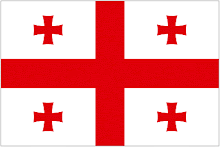 Map of Georgia
Map of Georgia
In 1975, the Georgian State Museum sponsored an archaeological expedition headed by Rusudan Dolaberidze. She carried out excavations on 'Nishtako' hill. This is located at the border of the village of Shenako, close to Omalo . The excavations revealed a terrace type of settlement characteristic to this mountainous area. She discovered 3 layers of different cultural ages: the 1-3.century B.C., the 3-4 century A.D. and the 6-8 century A.D.
Materials from the late Bronze & Early Iron Ages were found on 'Kurekhi' hill. This included everyday items. If you are interested the relics from this discovery are now kept at the National Museum of Georgia.
The earliest historical reference to Tusheti refers to the 3rd century B.C. this was during the reign of the first King of Georgia Parnavaz. This early written account belongs to a Greek geographer of the 2nd century A.D. called Ptolemaus who wrote about the geographical settlement of the Tushs . He went on to describe the Caucasian tribes - 'There are the Tusks ('Tuskoi' means 'Tushs') and the Diduri (the 'Didoels') between Caucasus and Kervani Mountains.'
Materials from the late Bronze & Early Iron Ages were found on 'Kurekhi' hill. This included everyday items. If you are interested the relics from this discovery are now kept at the National Museum of Georgia.
The earliest historical reference to Tusheti refers to the 3rd century B.C. this was during the reign of the first King of Georgia Parnavaz. This early written account belongs to a Greek geographer of the 2nd century A.D. called Ptolemaus who wrote about the geographical settlement of the Tushs . He went on to describe the Caucasian tribes - 'There are the Tusks ('Tuskoi' means 'Tushs') and the Diduri (the 'Didoels') between Caucasus and Kervani Mountains.'
 Tusheti can be found in region 5 tucked up between Dagestan and Chechen
Tusheti can be found in region 5 tucked up between Dagestan and ChechenFrom what I can understand the Tush population is divided into two parts – Tsova Tushs and Chaghma Tushs. There is little difference between these two groups apart from their language. The Chaghma Tushs speak one common language, a Georgian language dialect, which together with Pshav, Khevsurian and Mokhevian dialects is linguistically close to the Pkhovian group of the Georgian dialects. Are you still with me? The Tsova Tushs speak two languages. In informal surroundings, they commonly speak Tsova Tushetian or Batsbian. They speak the dialect somewhat similar to the Kahetian dialect of the Georgian language outside their homes. Please please contact me if this is incorrect since as an Englishman I can only note down what I’ve read and learned from my good friends.
So there you have it. Tusheti has been inhabited for a considerable time .There is some dispute over which tribes dominated this region due to the language of scholars confusing the names of different tribes but I think it is fair to say the Tush were named 'Tushs' by the Lezghins referring to the word 'Dusht' meaning 'Enemy'. Interstingly the Kists referred to the bravest warriors as 'Enemies'. The Kist being a tribe in Pankisi. I’ll stop here before I confuse myself. What is clear is the Tush were revered by all their neighbors and have inhabited the region since 1-3.century B.C.
It was not until the 9th century that the Tushs adopted Christianity. Since then they have had close contacts with the population of the plain, particularly that of Kaheti. The King of Kahetians Levan II (1520-1574) was among the first kings to open the way for the Tushs to the Alazani Valley, the home of some excellent wine.
The story goes in the XVII-XVIII centuries; the Tushs greatly supported the kings of Kartli and Kaheti in the wars at that time with the kingdom of Persia. As testament to the Tush’s bravery King Erekle II had several Tush warriors attending his court known as’ the bravest ones’. Zezva Gaprindauli was seen at that time as one of those ‘brave ones’ perhaps the greatest hero of Tusheti. His name is linked with the historical battle of Bakhtrioni. After freeing Bakhtrioni from the Persians in a very bloody battle the elders of the Tushs asked the King for a fertile homeland as a reward. The King agreed, but under one condition – he would grant the elders the homeland up to the point an elder rode his horse non-stop from Bakhtrioni. Our man Zezva rode his horse until it fell down dead. A good day for the Tush but a bad day for the horse. The King gratefully gave this small region to the Tushs where the towns of Kvemo Alvani and Zemo Alvani have been built along with many villages such as Laslisquir, a village close to my heart and where many people from Shenako live.
Many Tushetians live to this day in this area, especially in the winter months when those who make a living in the mountains come down to the plains to over winter their livestock.
If you have ever visited this area your will have noticed the abundance of fresh produce. The fertile plains are fed by an unrelenting supply of water from the Caucuses. This warm Mediterranean style climate is a perfect combination for farming and a magnificent place to eat, drink and live life to the full.

Thank
ReplyDeleteyou so much
DeleteJudith would love this God rest her soul
DeleteTsova Tushetians speak in 2 languages Georgian and Tsova Tushetian language which is very different from Georgian language or other Georgian regional languages for example Megrelian. most likely it’s gonna be forgotten Soon bc yang people Taiva Tushetians are less interested with studing it
ReplyDelete